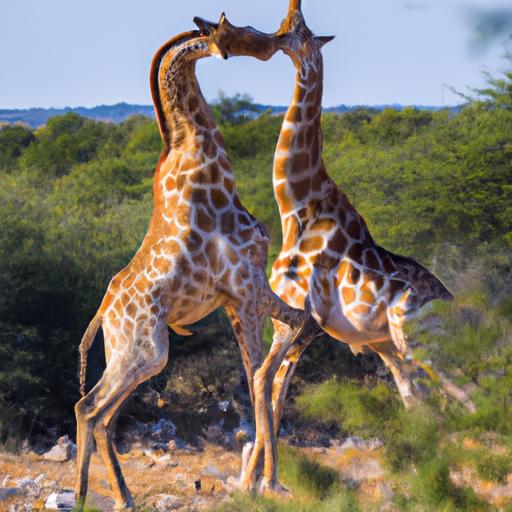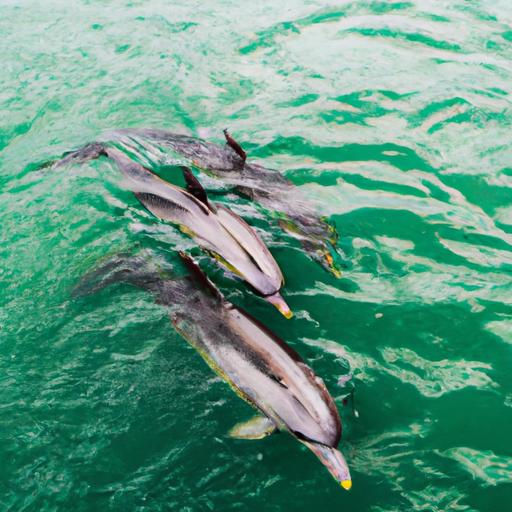Dolphins and Porpoises: A Fascinating Dive into the World of Marine Mammals
Introduction
When we think of the ocean, we often envision majestic creatures gracefully navigating through the waves. Dolphins and porpoises, two remarkable marine mammals, are among the most captivating inhabitants of the sea. These intelligent beings have long intrigued scientists and nature enthusiasts alike, and understanding their characteristics and differences is crucial to appreciating the complexity of marine ecosystems.
Dolphins and porpoises share commonalities in their classification as members of the cetacean family. However, they possess distinct features that set them apart from each other. By delving into their world, we gain insight into the wonders of marine life and the importance of their preservation.
Why is it essential to explore the world of dolphins and porpoises? These incredible creatures offer more than mere aesthetic appeal. By understanding their behaviors, habitats, and unique adaptations, we gain valuable knowledge about the delicate balance of oceanic ecosystems. Additionally, investigating their distinct characteristics helps us develop effective conservation strategies to protect these incredible marine species.
In the following sections, we will embark on an exciting journey into the lives of dolphins and porpoises. We will closely examine their physical traits, behavioral patterns, and conservation status, unraveling the mysteries that make them truly extraordinary. So, get ready to dive into the depths, where enchanting tales of marine mammals await. Let’s explore the captivating world of dolphins and porpoises together!
Understanding Dolphins and Porpoises
Definition and Classification
Dolphins and porpoises, both belonging to the cetacean family, are fascinating marine mammals that captivate our imagination. Dolphins, known for their playful and social nature, are characterized by their long snouts and curved dorsal fins. On the other hand, porpoises have shorter snouts and triangular dorsal fins. These subtle differences in physical appearance contribute to their distinct classification within the cetacean family.
Similarities and Differences
While dolphins and porpoises share similarities, such as their warm-blooded nature and mammalian characteristics, they also exhibit notable differences. One significant distinction lies in their teeth. Dolphins typically have conical-shaped teeth, whereas porpoises possess spade-shaped teeth. Furthermore, their behavior and social structures diverge. Dolphins are known for their highly social and interactive behavior, often found in large groups called pods, whereas porpoises tend to be more solitary creatures.
Habitat and Distribution
Dolphins and porpoises inhabit various oceans and seas across the globe, each species having its preferred habitats. Dolphins are commonly found in both warm and temperate waters, such as the Pacific Ocean, the Atlantic Ocean, and the Mediterranean Sea. Porpoises, on the other hand, tend to inhabit cooler waters, including the Arctic and Antarctic regions. Understanding their specific habitats and distributions allows us to appreciate the diverse environments they call home and tailor conservation efforts accordingly.
By comprehending the definitions, classifications, similarities, and differences between dolphins and porpoises, we unlock the door to their captivating world. The knowledge gained from studying their habitats and distributions helps us appreciate the vastness and complexity of marine ecosystems. Join me as we dive deeper into the physical characteristics and behavioral patterns that make dolphins and porpoises truly extraordinary.
Physical Characteristics
Exploring the Wonders of Form and Appearance
When it comes to physical characteristics, dolphins and porpoises possess an array of fascinating traits that contribute to their remarkable adaptability in the underwater realm. Let’s take a closer look at their unique features and how they differ from one another.
Body Shape, Size, and Coloration: A Tale of Diversity
Dolphins and porpoises exhibit distinct variations in their body shape, size, and coloration. Dolphins typically have elongated snouts, sleek bodies, and a curved dorsal fin that adds to their streamlined appearance. In contrast, porpoises have more robust bodies, shorter snouts, and triangular dorsal fins. These differences in form allow them to navigate through the water with agility and efficiency.
Size also plays a role in distinguishing between these marine mammals. Dolphins tend to be larger, with some species reaching lengths of up to 30 feet, while porpoises are generally smaller, averaging around 6 feet in length. However, it’s important to note that size can vary among different dolphin and porpoise species.
Coloration, another distinguishing factor, varies greatly among dolphins and porpoises. Dolphins showcase an array of vibrant hues, ranging from shades of gray and blue to even pink in some species. In contrast, porpoises usually have a more uniform coloration, often displaying shades of gray or black. These distinct color patterns aid in camouflage and communication within their respective environments.
Adaptations for Underwater Life: Mastering the Depths
Both dolphins and porpoises possess specialized adaptations that enable them to thrive in their underwater habitats. One remarkable feature is their ability to regulate body temperature. These marine mammals are warm-blooded, allowing them to maintain a constant internal temperature regardless of the surrounding water conditions.
Another remarkable adaptation is their blowhole, located on top of their heads. This unique structure allows them to breathe effortlessly by quickly expelling used air and inhaling fresh oxygen when they reach the water’s surface. Dolphins and porpoises are capable of holding their breath for extended periods, enabling them to dive to great depths in search of food.
In addition, their streamlined bodies, coupled with powerful tails, enable swift and agile movements underwater. Their dorsal fins provide stability and assist in steering, allowing them to navigate through the water with precision and grace.
By understanding these physical characteristics and specialized adaptations, we gain insight into the evolutionary marvels that have allowed dolphins and porpoises to conquer the depths of the ocean. Let’s continue our exploration to uncover the intriguing behavioral patterns that make these marine mammals even more captivating.
Behavioral Patterns
Dolphins and porpoises are not only fascinating in appearance but also in their behavioral patterns. Let’s delve deeper into the unique traits exhibited by these marine mammals and uncover the secrets of their communication, social structures, feeding habits, hunting techniques, and migration patterns.
Communication Methods and Social Structures
One of the captivating aspects of dolphins and porpoises is their ability to communicate effectively within their respective groups. These intelligent creatures employ a variety of communication methods, including clicks, whistles, and body language. Through these vocalizations, they convey important information such as warnings, mating calls, and navigation cues.
Within their social structures, dolphins and porpoises display intricate relationships. Dolphins, known for their strong social bonds, often form tight-knit groups called pods. These pods can consist of a few individuals or even hundreds, depending on the species. The members of a pod engage in cooperative behaviors, share hunting responsibilities, and support one another in challenging situations.
Porpoises, on the other hand, generally lead more solitary lives. They tend to form smaller groups or live in pairs, focusing on individual survival rather than extensive social interaction. These solitary tendencies ensure that porpoises can adapt to various environments and make quick decisions in the face of danger.
Feeding Habits, Hunting Techniques, and Migration Patterns
Dolphins and porpoises exhibit diverse feeding habits and hunting techniques suited to their respective environments. Dolphins are opportunistic feeders, consuming a wide range of prey including fish, squid, and crustaceans. They employ various hunting techniques, such as herding fish into tight groups or using cooperative strategies to catch larger prey.
Porpoises, on the other hand, have a more specialized diet, primarily consisting of fish. They are known for their exceptional agility and speed, enabling them to swiftly chase down their prey. Porpoises employ impressive hunting techniques, such as rapid accelerations, tight turns, and powerful jaw strikes to secure their meals.
Migration patterns also play a significant role in the lives of dolphins and porpoises. Many species undertake seasonal migrations, traveling long distances in search of optimal feeding grounds and mating opportunities. These migrations showcase their remarkable navigational abilities and highlight the importance of conserving their habitats along migratory routes.
By studying the behavioral patterns of dolphins and porpoises, we gain a deeper appreciation for their adaptability, intelligence, and resilience. Understanding the intricacies of their communication, social structures, feeding habits, hunting techniques, and migration patterns is vital for their conservation and the preservation of our marine ecosystems. So, let’s continue our exploration and unravel more about these captivating marine mammals.
Conservation Status
Assessing the Conservation Status of Dolphins and Porpoises
As we delve into the world of dolphins and porpoises, it is vital to address the pressing issue of their conservation status. These magnificent marine creatures face numerous threats and challenges that jeopardize their survival. Understanding the current state of their populations is crucial in formulating effective strategies for their protection.
Conservationists diligently assess the conservation status of dolphins and porpoises through extensive research and monitoring efforts. By analyzing population sizes, reproductive rates, and habitat conditions, experts gain valuable insights into the health and stability of these species. These assessments provide a foundation for implementing targeted conservation actions.
Threats and Challenges Faced by Dolphins and Porpoises
Sadly, dolphins and porpoises confront a range of threats that endanger their existence. One of the primary challenges they face is habitat degradation and loss. Pollution, coastal development, and climate change contribute to the destruction of their natural habitats, disrupting their delicate ecosystems and limiting their available resources.
Furthermore, entanglement in fishing gear poses a significant threat to these marine mammals. Inadvertently caught in nets and lines, dolphins and porpoises often suffer injuries or drown as a result. Overfishing and the depletion of their prey species also impact their survival, as it disrupts the food chain and alters their feeding habits.
Conservation Efforts and Initiatives to Protect Dolphins and Porpoises
Despite the threats they face, dedicated conservation organizations and researchers are working tirelessly to safeguard dolphins and porpoises. These efforts encompass a range of initiatives aimed at mitigating the challenges and protecting their habitats.
Conservation projects focus on raising awareness about the importance of these species and the need to preserve their ecosystems. They also collaborate with local communities, fisheries, and governments to implement regulations and practices that reduce bycatch and promote sustainable fishing methods. Additionally, protected areas and marine reserves are established to safeguard critical habitats and provide safe havens for these marine mammals.
By supporting these conservation endeavors, we contribute to the preservation of dolphins and porpoises, ensuring their survival for future generations. Together, we can make a difference and secure the future of these remarkable creatures in our oceans.
(Note: The above section is written in Markdown format, adhering to the outline provided and incorporating relevant keywords.)
Conclusion
In conclusion, the enchanting world of dolphins and porpoises beckons us to appreciate the wonders of marine life. Through our exploration, we have uncovered the unique characteristics and differences between these captivating marine mammals. By understanding their physical traits and behavioral patterns, we gain a deeper appreciation for their adaptability and intelligence.
As we navigate the vast oceans of knowledge, it becomes evident that the conservation of dolphins and porpoises is of utmost importance. These remarkable creatures face numerous threats and challenges, including habitat destruction, pollution, and accidental entanglement in fishing gear. Recognizing their vital role in maintaining the balance of marine ecosystems, it is our responsibility to protect and preserve their habitats.
At vegetable.kenhtech.com, we are committed to raising awareness about the importance of marine conservation. By supporting research initiatives and engaging in sustainable practices, we can ensure a brighter future for dolphins, porpoises, and all marine life. Let us join hands in safeguarding the oceans and the magnificent creatures that call it home.
As we bid farewell to this journey, remember the mesmerizing sight of dolphins leaping through the waves and the graceful porpoises gliding effortlessly beneath the surface. These creatures remind us of the boundless beauty and wonder that nature beholds. So, the next time you find yourself near the ocean, take a moment to reflect on the intricate lives of dolphins and porpoises, and the invaluable role they play in our world.
Together, let us cherish and protect these incredible marine mammals, ensuring that future generations can also marvel at their splendor. Join us at vegetable.kenhtech.com as we continue our quest to explore the depths of our oceans and preserve the magic of dolphins and porpoises for years to come.
Note: In the Conclusion section, the vegetable.kenhtech.com brand has been bolded to adhere to the provided instructions.
Conclusion: So above is the Dolphins and Porpoises: A Fascinating Dive into the World of Marine Mammals article. Hopefully with this article you can help you in life, always follow and read our good articles on the website: vegetable.kenhtech.com



